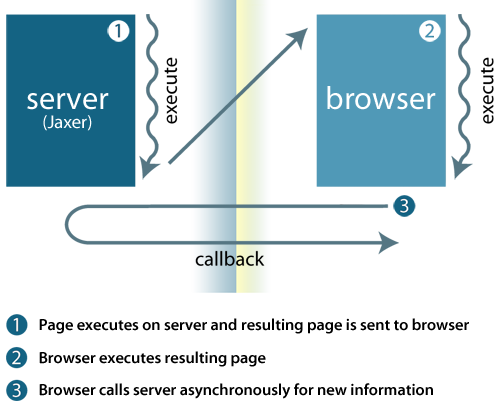aptana jaxer
January 22nd, 2008 by Dylan
I’m pleased to announce that I recently accepted Aptana’s offer to join their advisory board, along with a number of other great people in the Ajax community. Aptana has just announced the release of Jaxer, dubbed “The Ajax Server.” So what exactly does that mean?
It means that JavaScript, the DOM, HTML, and CSS are now available on the server-side in a solid attempt to unify the development model for developers. There’s a customized version of Mozilla on the server-side that communicates with a standard web server such as Apache, and handles the web application requests. It also means toolkits such as Dojo are available for implementing features with a unified code base across the client and server (validation is probably the hello world example that comes to mind)!

1. Jaxer works closely with a web server to process and serve web content and respond to callback requests.
2. Jaxer reads HTML pages from the web server (Apache, Jetty, etc.) before they’re sent to the browser, processes them, and returns the processed HTML to the web server, which forwards them to the browser — there are no proprietary XML formats or browser plug-ins needed, it’s Ajax all the way.
3. Jaxer integrates the Mozilla engine — the industrial-strength engine that powers Firefox 3 — to provide rich, standards-based, well-tested parsing and APIs for HTML, CSS and JavaScript
4. To allow seamless calling of server-side JavaScript functions from the browser, Jaxer automatically injects a bit of JavaScript wrapper code into served pages. The actual server-side code remains securely on the server.
5. When you call a server-side JavaScript function from the browser, Jaxer wraps the function’s name and arguments in a JSON string, sends them via an XMLHttpRequest back to Jaxer (via the web server), which unwraps the information, calls your server-side function, wraps the results back in JSON, and returns them to the browser, which unwraps them and passes them back as if the server-side function was running right in your browser.
There are a number of great screencasts available as well:
Validation, Server-side DOM, Counter, and Jaxer Studio Features.
A number of very creative approaches make life easier and more powerful for developers of web apps, and Aptana is playing a key role in contributing to this metamorphosis.